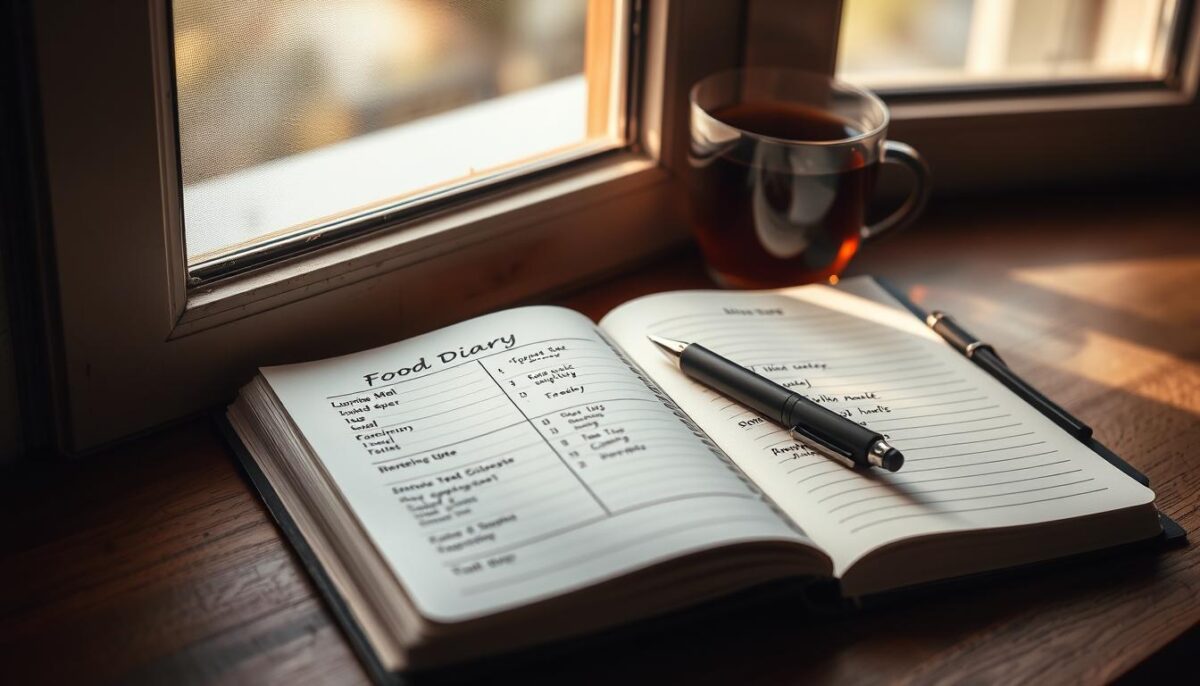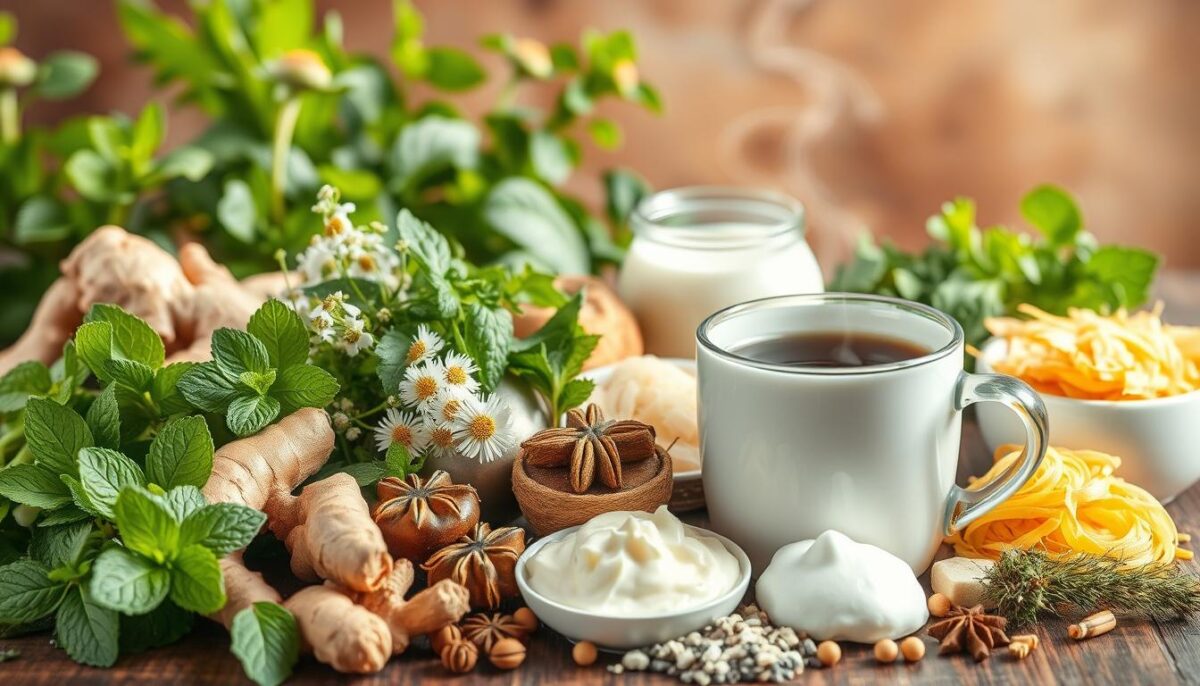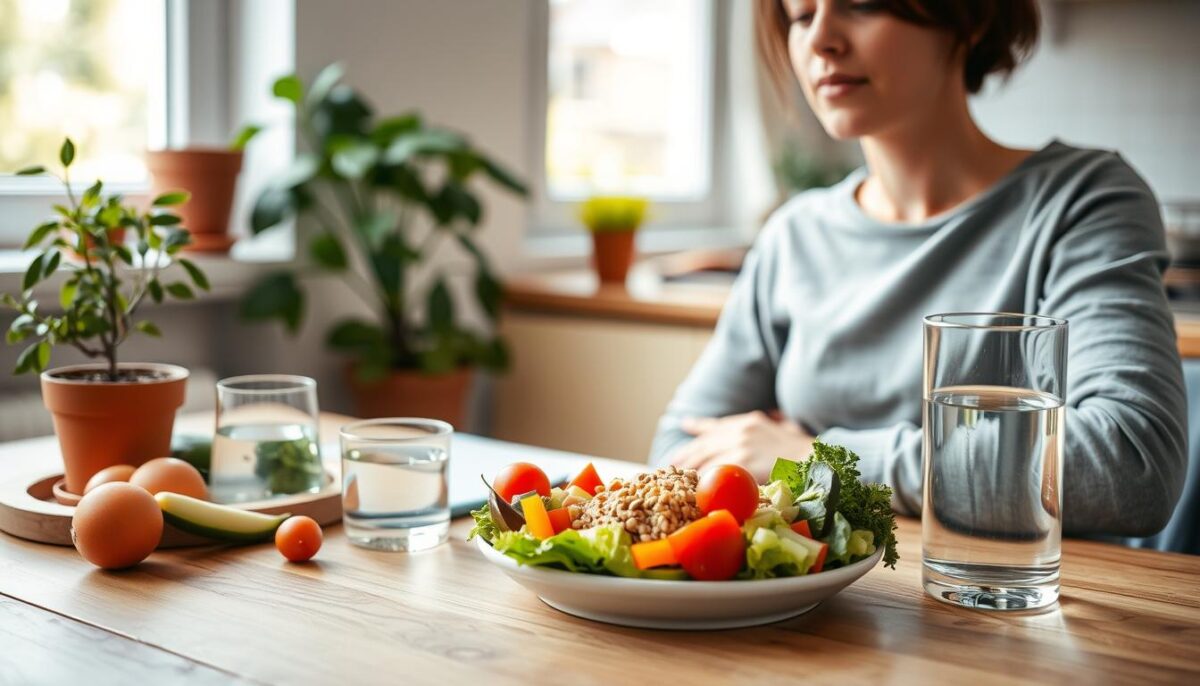
What You Should Never Eat on an Empty Stomach
May 23, 2025
Best Foods for IBS Relief According to Nutrition Experts
May 24, 2025Did you know your body produces 1–3 pints of gas daily? That’s enough to fill a small balloon! While it might feel awkward to discuss, occasional digestive discomfort affects nearly everyone. I used to feel embarrassed when my stomach growled during meetings or after meals—until I realized this was my body’s way of communicating.
My turning point came when I learned that what we eat directly shapes our gut’s behavior. Swapping processed snacks for ginger tea or probiotic-rich yogurt didn’t just ease my symptoms—it transformed how I viewed food as medicine. Simple tweaks, like chewing slowly and staying hydrated, became my secret weapons against discomfort.
What surprised me most? Many solutions were already in my kitchen. Peppermint leaves steeped in hot water worked better than some over-the-counter options. By tracking meals and observing patterns, I discovered which ingredients fueled my system versus those that caused chaos.
Key Takeaways
- The average adult’s digestive system creates gas 13–21 times daily
- Dietary adjustments often provide faster relief than medications
- Hydration and mindful eating habits prevent trapped air
- Fermented foods support healthy gut bacteria balance
- Meal timing impacts digestion efficiency
Understanding Gas, Bloating, and Digestive Health
Gas and bloating are like your gut’s way of sending a text message—if you learn to read it. Early in my journey, I discovered that discomfort often starts with how our bodies process food. Let’s decode what’s happening behind the scenes.
Common Causes of Gas and Bloating
Your intestine hosts a bustling community of bacteria breaking down food. This process creates gas as a natural byproduct. But certain habits turn this normal function into a problem:
- Swallowing air while eating quickly or sipping carbonated drinks
- Overloading your system with large meals or high-fiber foods
- Chewing gum regularly, which introduces excess air into your tract
A Johns Hopkins study notes that carbonated beverages alone may cause 37% more gas production. I realized my afternoon soda habit was fueling my discomfort.
Recognizing Your Body’s Digestive Signals
My turning point came when I started noticing patterns. Mild pressure after meals? A hint to slow down. Sharp cramps? Time to review what I ate. Tracking meals in a journal helped me connect foods like beans or cruciferous veggies to specific symptoms.
Listening to these cues may help you adjust your diet before minor issues escalate. One friend discovered her “healthy” kale smoothies were the culprit behind her bloating—proof that even nutritious choices can backfire.
The Impact of Diet on Gas and Bloating
Your plate holds more power over your digestion than you might realize. Early in my journey, I discovered that specific ingredients could either calm or ignite my digestive system. Tracking meals became my compass for pinpointing patterns—like how a cheesy omelet left me feeling heavy, while oatmeal with berries kept things smooth.
Identifying Trigger Foods
My relationship with food changed when I noticed how beans or ice cream consistently caused discomfort. Common culprits often include:
- Dairy products (lactose intolerance affects nearly 65% of adults globally)
- High-FODMAP veggies like broccoli and cauliflower
- Carbonated drinks introducing excess air
After swapping milk for almond alternatives and steaming cruciferous greens, my symptoms softened. A food diary helped me spot trends I’d otherwise miss—like how applesauce triggered cramps but baked apples didn’t.
Balancing Fiber and Nutrient Intake
Fiber’s a double-edged sword. While whole grains and lentils support regularity, overdoing them led to constipation for me. I learned to pair high-fiber foods with hydration and lean proteins. For example, adding chia seeds to yogurt instead of eating them dry made a noticeable difference.
Small shifts matter. Roasting veggies instead of eating them raw, or blending spinach into smoothies, helped my body process nutrients without strain. It’s not about elimination—it’s about creating harmony on your plate.
Tips for Using Food to Improve Digestion
Your kitchen holds secrets to better digestion—if you know how to listen. Through trial and error, I found two strategies that transformed my relationship with meals: pattern recognition and portion recalibration. These approaches taught me how everyday choices impact my digestive tract.
Keeping a Food Diary
I started scribbling notes about every snack and sip in a battered notebook. Tracking meals revealed surprising connections—like how lentils gave me energy but also caused mild cramping. My system tolerated roasted carrots better than raw ones, teaching me that preparation matters.

Hydration patterns emerged too. Drinking water between meals instead of during them reduced that “sloshing” feeling. Now I use a color-coded app to log portions, timing, and symptoms. This habit helped me spot foods that may help ease discomfort, like steamed zucchini over raw peppers.
Adjusting Meal Sizes and Portions
Switching from three large meals to five smaller ones changed everything. My body processes palm-sized portions more efficiently than plate-filling feasts. Chewing slowly became my new dinner ritual—it cuts down on swallowed air and lets me savor flavors.
Nutritionists agree: “Overloading your system triggers backup, while modest meals keep things moving”. I balance fiber-rich foods with lean proteins, like pairing brown rice with grilled chicken. These tweaks brought gradual relief without drastic diet changes—proof that small shifts can yield big results.
Reduce gas bloating naturally
Turning everyday ingredients into digestive allies changed my comfort levels. I discovered that specific kitchen staples act like internal massage therapists, easing tension without harsh interventions. The key? Choosing items that work with your body rather than against it.
Nutrients and Foods That Soothe Your Stomach
My morning ritual now includes warm water with a splash of apple cider vinegar. This tangy mix may help your system break down meals more smoothly. Fermented foods like kimchi became my go-to side dish—their probiotics support gut balance better than any pill I’ve tried.
Roasted fennel seeds surprised me most. Chewing a teaspoon after meals softened that “stuffed” feeling. I also lean on ginger tea when my intestine feels rebellious—its natural warmth quiets cramping better than I expected.
Practical Food-Based Techniques for Relief
Timing matters as much as ingredients. I drink liquids 30 minutes before eating to prevent diluting digestive juices. Combining high-fiber foods with healthy fats—like avocado on whole-grain toast—creates a satisfying combo that moves through me without drama.
One gastroenterologist’s advice stuck with me: “Your gut craves consistency more than complexity”. Now I eat papaya or pineapple with heavier meals—their enzymes act like built-in cleanup crews. These tweaks transformed my diet from a minefield to a roadmap for comfort.
Natural Remedies and Home Solutions
Nature’s medicine cabinet offers surprising solutions for digestive harmony. Through experimentation, I’ve found that simple additions to my routine often work better than drastic changes—especially when addressing issues like irritable bowel syndrome.

Herbal Teas and Essential Supplements
Peppermint tea became my evening ritual after discovering its muscle-relaxing properties. A nutritionist friend explained: “The menthol in peppermint acts like a warm compress for your digestive tract”. Chamomile with honey now replaces my after-dinner coffee, easing that heavy feeling without side effects.
I rotate supplements based on my body’s needs—digestive enzymes with heavy meals, magnesium for regularity. Probiotic gummies surprised me most. Unlike pills, they helped maintain gut balance during travel without refrigeration hassles.
Using Activated Charcoal and Other Aids
When discomfort strikes, activated charcoal capsules help relieve pressure within hours. I keep them handy for restaurant meals or unfamiliar foods. They work like a sponge, trapping excess gas before it causes distress.
Over-the-counter medications remain a last resort. For quick relief, I combine charcoal with gentle belly massage—clockwise circles following my colon’s path. This duo often resolves issues without harsh chemicals.
Through trial and error, I’ve learned that consistency matters more than complexity. Now I research products through medical journals before trying them. Small, tested adjustments create lasting comfort better than chasing every new trend.
Lifestyle Changes That Enhance Digestive Comfort
Your daily habits might be whispering secrets to your gut. I discovered that how I move impacts my digestion as much as what I eat. Small adjustments to my routine brought unexpected relief—especially when paired with mindful eating practices.

Movement as Medicine
Morning walks became my secret weapon. A 20-minute stroll after breakfast helps my system process meals smoothly. Yoga’s twisting poses, like seated spinal twists, often release trapped air better than any supplement.
Deep breathing surprised me most. I practice 4-7-8 breathing: inhale for 4 counts, hold for 7, exhale for 8. This rhythm calms my nervous system and reduces tension that can worsen discomfort. My physical therapist noted: “Diaphragmatic breathing massages internal organs, promoting natural motility”.
| Activity | Frequency | Benefit |
|---|---|---|
| Brisk Walking | Daily 20 mins | Stimulates bowel function |
| Cat-Cow Stretch | 3x/week | Relieves abdominal pressure |
| Box Breathing | Morning & Evening | Reduces swallowed air |
I pair these habits with peppermint tea—its natural properties complement movement’s effects. Consistency matters more than intensity. Even folding laundry while marching in place helps keep things flowing.
These changes didn’t erase every symptom, but they created lasting improvement. Combined with fiber-rich meals and hydration, they’ve become my foundation for digestive ease. Your body might need different rhythms—start small and listen closely.
When to Seek Medical Advice for Digestive Issues
Listening to your gut requires knowing when to ask for backup. While peppermint tea and food journals helped me manage daily discomfort, I learned some signals demand professional attention. WebMD notes that 15% of Americans experience chronic digestive symptoms needing medical evaluation.
Recognizing Warning Signs and Persistent Symptoms
My wellness journal revealed patterns requiring action. When these red flags appeared consistently, I knew it was time to consult my doctor:
| Symptom | Duration | Action |
|---|---|---|
| Blood in stool | Single occurrence | Urgent consultation |
| Unexplained weight loss | 2+ weeks | Diagnostic tests |
| Severe abdominal pain | 48+ hours | Emergency care |
My gastroenterologist shared wisdom I now live by:
“Discomfort that disrupts daily life for over three weeks deserves investigation—your body isn’t being dramatic, it’s asking for help.”
I discovered that irritable bowel syndrome often requires tailored treatments beyond diet changes. When my cousin ignored recurring constipation and bloating for months, she needed prescription medications to restore her colon function.
Tracking symptoms in a dedicated app helped me communicate clearly with healthcare providers. I note frequency, intensity, and triggers—details that help distinguish occasional indigestion from potential disease.
Over-the-counter products like simethicone can help relieve mild gas, but persistent air buildup in your digestive tract might indicate deeper issues. Don’t self-diagnose—my peace of mind came from partnering with professionals who decoded my body’s SOS signals.
Conclusion
Navigating digestive wellness taught me that small, consistent choices create lasting change. Through dietary shifts and mindful habits, I’ve found freedom from daily discomfort—without relying on medications. Tracking meals and adjusting portions became my compass for understanding what fuels versus frustrates my system.
Three strategies made the biggest difference: identifying food intolerances through trial and error, using peppermint tea to calm cramping, and prioritizing movement after meals. These aren’t quick fixes but sustainable practices that build over time.
What works for one person might not for another—that’s why listening to your body matters most. If symptoms like sharp pain or persistent pressure disrupt your life, consult a healthcare professional. They helped me rule out serious conditions while refining my approach.
True relief comes from balance, not perfection. Start with one change—maybe swapping carbonated drinks for herbal infusions or adding a post-meal walk. With patience and observation, you’ll discover your unique path to digestive ease.
FAQ
What foods commonly trigger gas and bloating?
I’ve noticed that beans, broccoli, and carbonated drinks often cause discomfort. Dairy products like milk or cheese can also be tricky if you’re lactose intolerant. Processed snacks with artificial sweeteners (like sorbitol) might sneak in extra air, too.
Can increasing fiber make my stomach feel worse?
It can if you ramp up too quickly! I recommend adding fiber-rich foods like oats or chia seeds gradually. Pairing them with plenty of water helps your digestive system adjust without overwhelming it.
Does peppermint tea really help with IBS symptoms?
Absolutely! Sipping peppermint tea has been a game-changer for me. The menthol in peppermint relaxes intestinal muscles, easing cramping. Brands like Traditional Medicinals offer great organic options.
How does exercise improve digestive comfort?
Gentle movements like yoga or walking stimulate your gut’s natural rhythm. I’ve found that even 10 minutes of stretching after meals helps move trapped air through my system, reducing pressure.
When should I talk to a doctor about persistent bloating?
If you’re experiencing sharp pain, sudden weight loss, or blood in your stool, don’t wait. These could signal conditions like celiac disease or inflammatory bowel syndrome. Trust your gut—literally!
Can activated charcoal supplements help with gas?
They’ve worked for me during flare-ups! Activated charcoal binds to excess gas in the colon. Just check with your doctor first, especially if you’re on medications—it can interfere with absorption.
Are probiotics worth trying for irritable bowel syndrome?
Yes! Strains like *Bifidobacterium* in Culturelle or Align supplements have eased my cramping. Start slow—too much too soon might temporarily increase gassiness as your microbiome adjusts.



